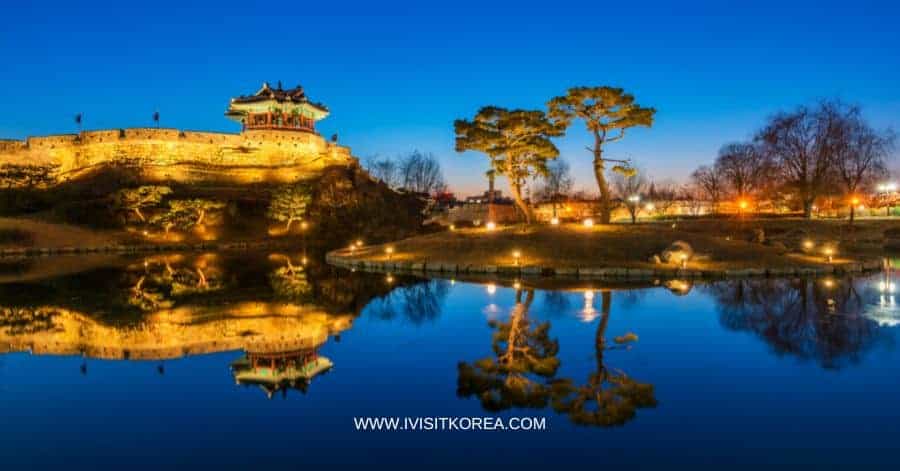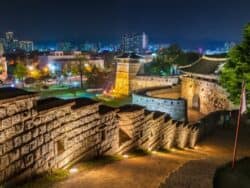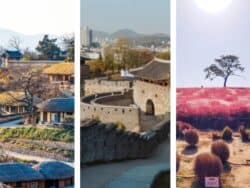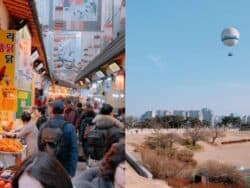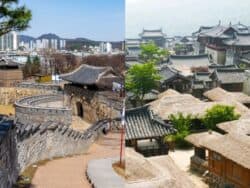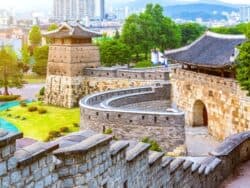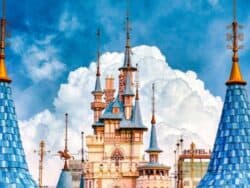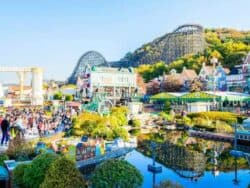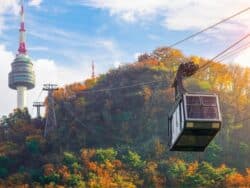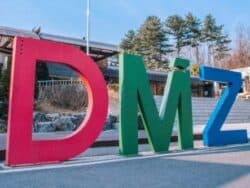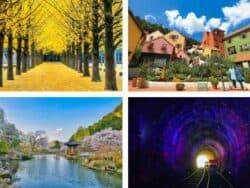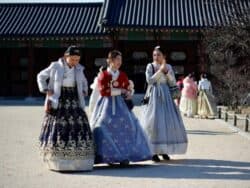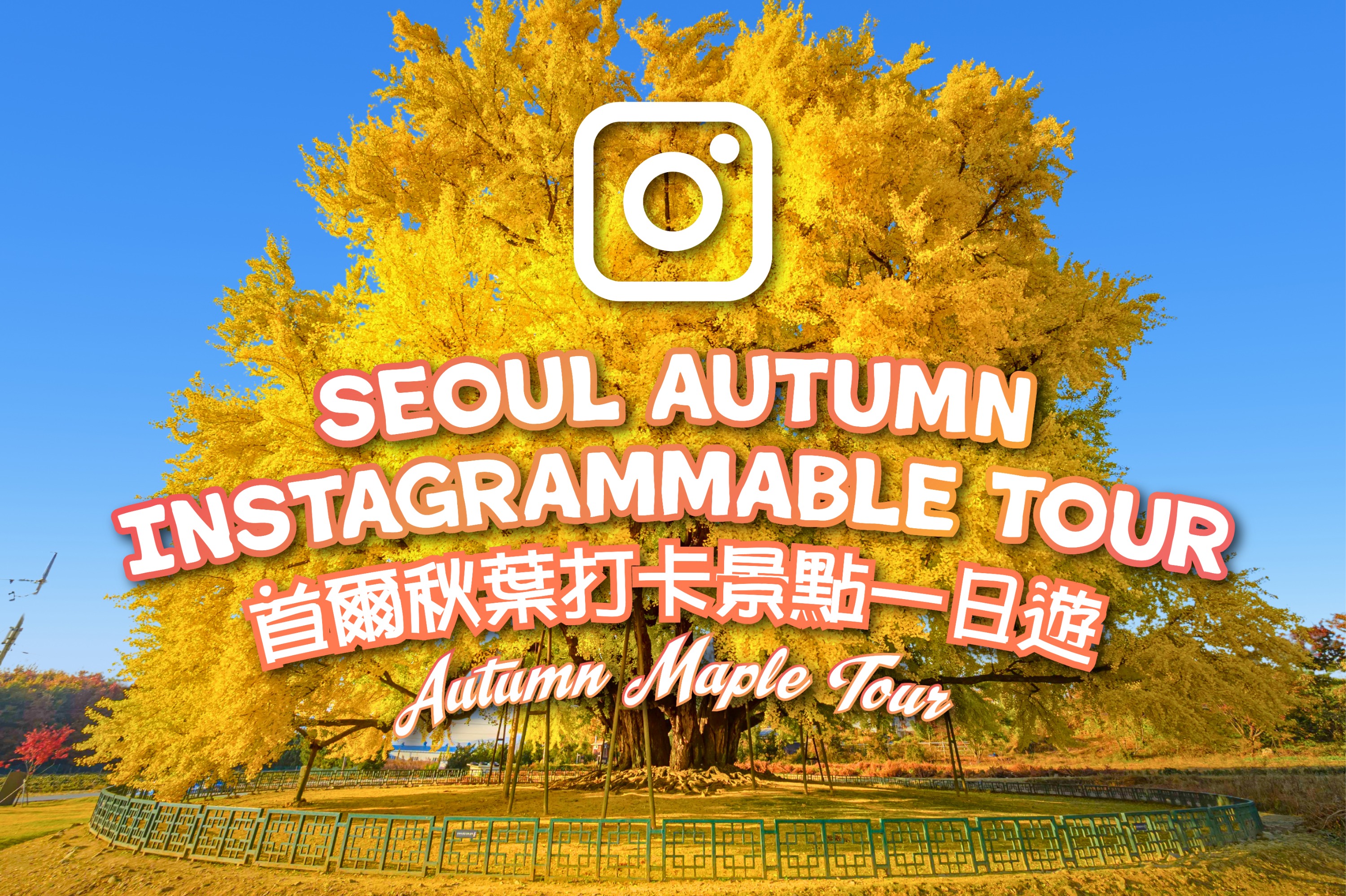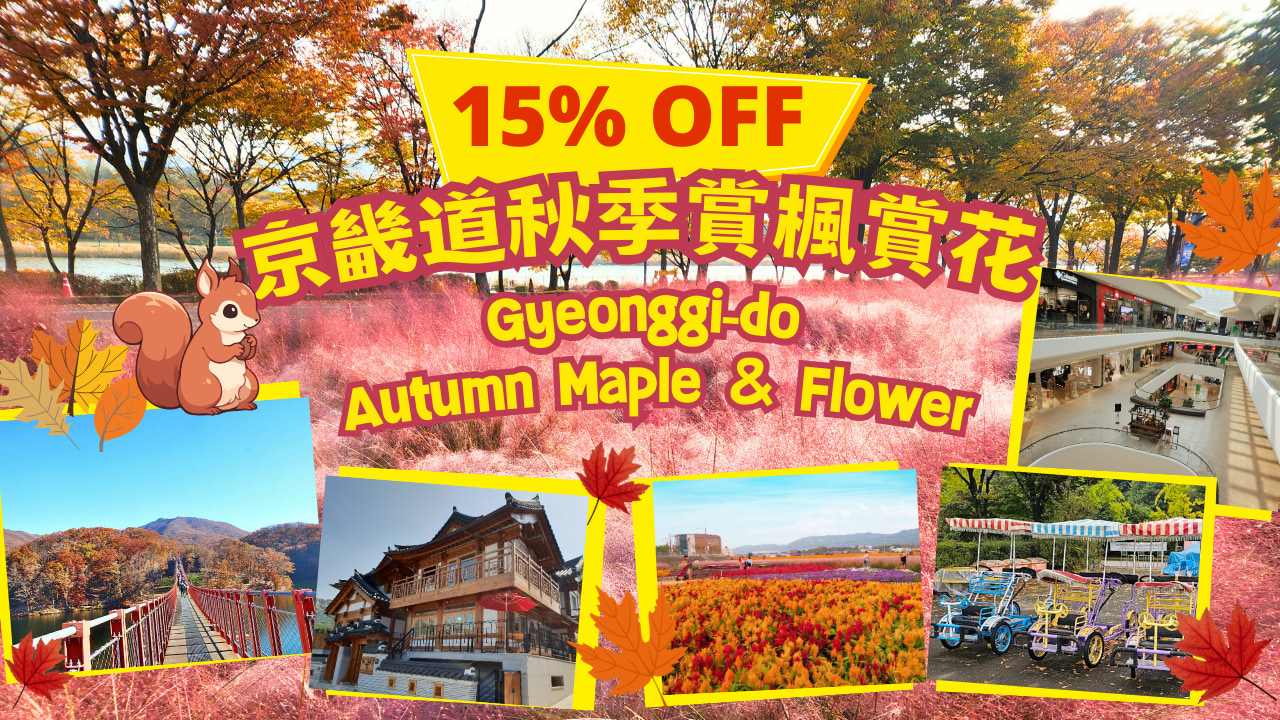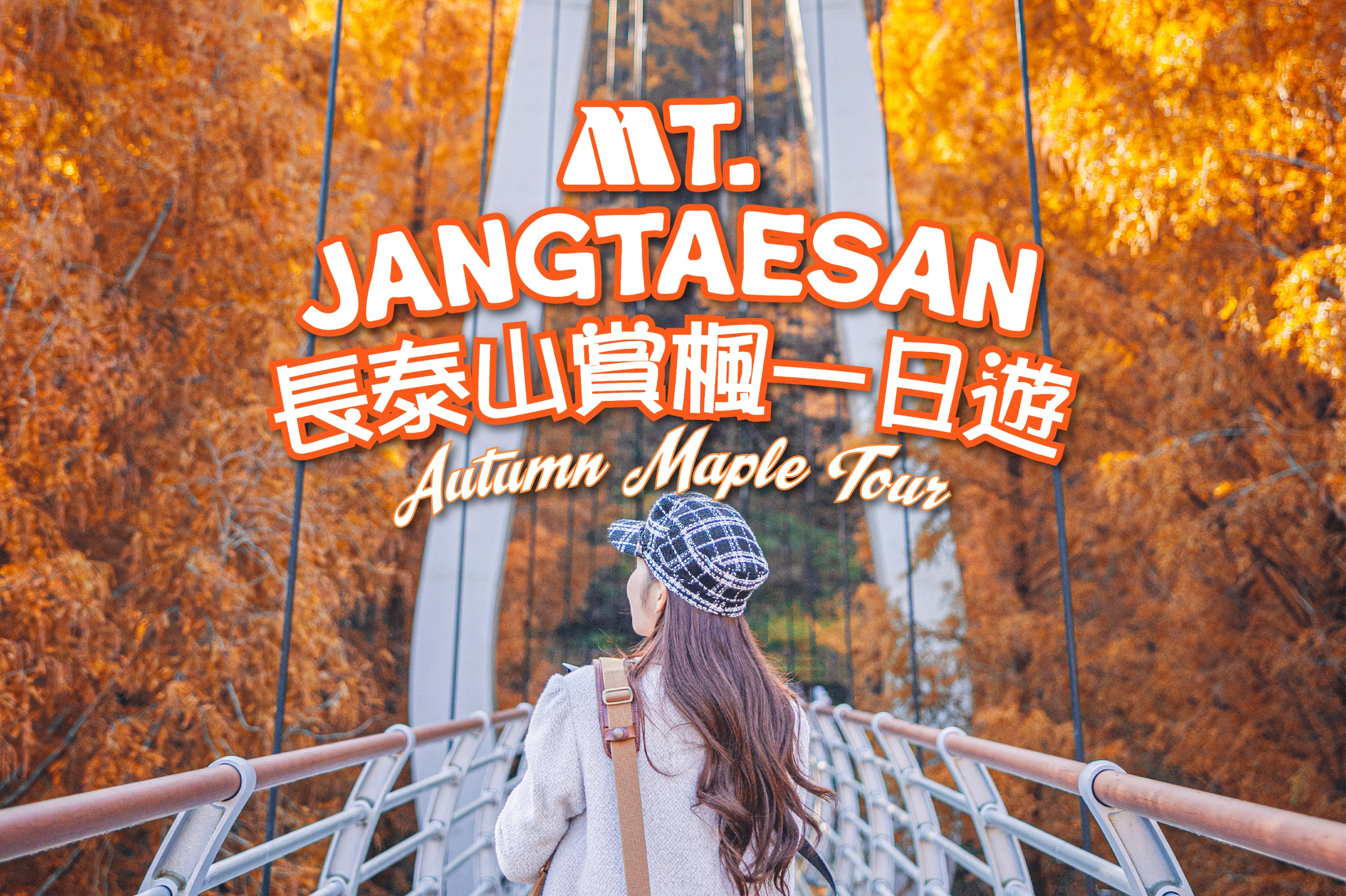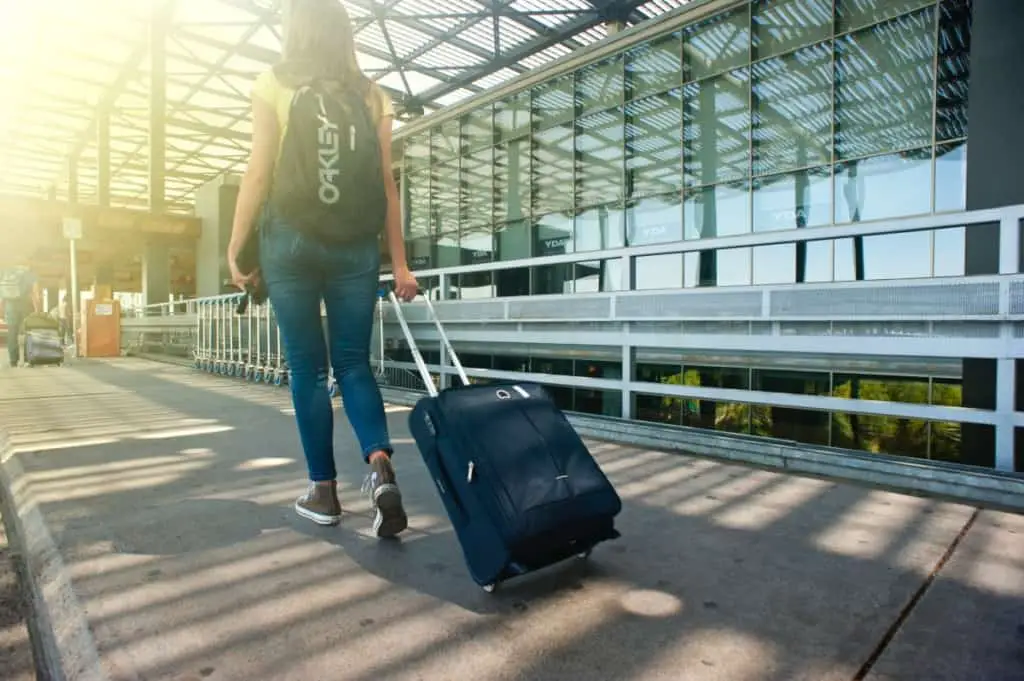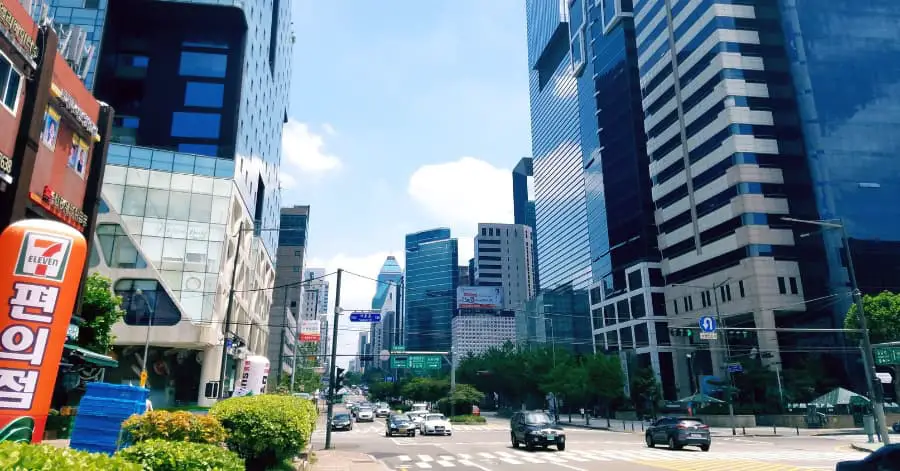Another popular city tourist destination aside from Seoul and Busan is none other than Suwon, the largest city in the Gyeonggi-do province. A different experience than the bustling Seoul or ocean-side Busan, Suwon is a must-visit if you like exploring historical sites where you can learn more about the Joseon Dynasty in South Korea. FYI, Suwon almost became the capital of South Korea in the 18th century when King Jeongjo built a 5.7 km long wall in 1794-1796 before moving the capital south. Therefore, there are many historical relics and monuments left that visitors can still enjoy to this day, one of them being the famous Hwaseong Fortress. Want to know more about them? Here are the top 12 tourist attractions in Suwon and what you can do to make the most of your holiday!
- Top Things to do in Suwon
- Suwon Hwaseong Fortress (수원화성)
- Hwaseong Haenggung Palace (화성행궁)
- Suwon Hwaseong Museum (수원화성 박물관)
- Banghwasuryujeong Pavilion (방화수류정)
- Flying Suwon (플라잉 수원)
- Aqua Planet Suwon (아쿠아플라넷 광교)
- Manseok Park (만석공원)
- Gwanggyo Lake Park (광교호수공원)
- Haewoojae (해우재) / Toilet House
- Gwanggyo Reservoir (광교저수지)
- Chilbosan Mountain (칠보산)
- Hyowon Garden (효원공원월화원)
Top Things to do in Suwon
Suwon Hwaseong Fortress (수원화성)
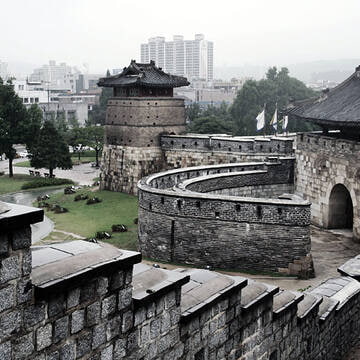
[Source: UNESCO World Heritage]
Listed as a UNESCO World Heritage in 1997, the Suwon Hwaseong Fortress is a fort wall enclosing the original city of Suwon. The fortress is located in the Paldal-san mountains (143 meters above sea level) and spans 5.7 km through four main gates, command posts, pavilions, observation towers, and fire-beacon platforms. It was built from 1794 to 1796 under the rule of King Jeongjo of Joseon to honor his late father Prince Sado. Some of the original buildings are damaged in the past, but they had been restored and preserved to retain their original shape. Visitors often visit the nearby sites Hwaseong Haenggung Palace, Hwaseong Trolley, and the Korean Archery Center where you can practice traditional Joseon-style archery!
- Location: 11, Haenggung-ro, Paldal-gu, Suwon-si, Gyeonggi-do, South Korea
- Open Hours: Mon-Sun: 9AM-6PM (summer), 9AM-5PM (winter)
- Contact details: Tel: +82 31 251 4435 / 4437 / Email: [email protected]
- Entrance Fee: 1,000 KRW / adult
- How to get here: Get off at Suwon station (line 1). Take buses 5 or 7 from the station and get off at the Jagan Park stop.
Hwaseong Haenggung Palace (화성행궁)
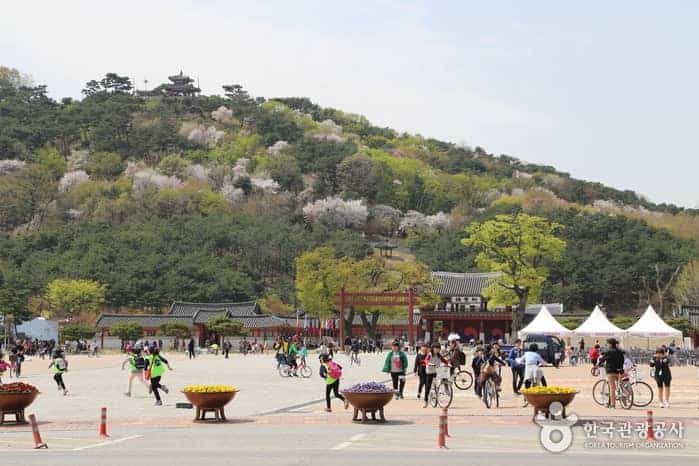
[Source: Korean Tourism Organization]
So if you’re wondering what is the Hwaseong Fortress protecting? Well, it’s none other than the royal palace nearby, the Hwaseong Haenggung Palace. The palace was built by King Jeongjo in the late 18th century as his residence when he visited his father’s grave. Haenggung itself refers to a temporary palace where the royal family stayed during the war. When the King was here, they held royal celebrations and feasts, including award ceremonies and other cultural events.
The months between March to November are great times to see the various traditional performances held in the square in front of the palace, including a changing of the guard ceremony. And if you visit during October, you’ll get the once-in-a-year chance to witness the grand royal procession as one of the annual Suwon festival’s events. Anyway, the famous Korean drama Moon Embracing the Sun used this palace as one of its shooting locations.
- Location: 825, Jeongjo-ro, Paldal-gu, Suwon-si, Gyeonggi-do
- Open Hours: Mon-Sun: 09:00-18:00
- Contact details: Tel: +82-31-228-4677, 4480 / Suwon cultural website: www.swcf.or.kr
- Entrance Fee: Individual – Adults 1,500 KRW / Teenagers 1,000 won / Children 700 won
- Group – Adults 1,200 won / Teenagers 800 won / Children 500 won
- How to get here: From Suwon Station Bus Stop, take Bus No. 11 or 13 and get off at Hwaseong Haenggung Bus Stop
Suwon Hwaseong Museum (수원화성 박물관)
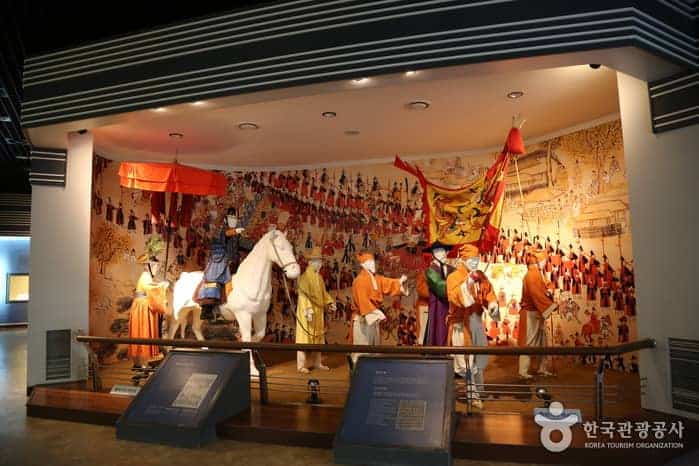
[Source: Korean Tourism Organization]
To finish off your visit after the fortress and the palace, don’t forget to stop by the Suwon Hwaseong Museum. This museum houses everything related to Suwon Hwaseong Fortress, both in terms of construction and the culture behind it. It’s different from the Suwon Museum, which is more general about Korean history and Suwon in particular. Visitors can learn and explore the historical heritage of Korea, especially in the 18th century, when King Jeongjo of the Joseon Dynasty ruled and instructed the construction of a fort in Suwon City. The Suwon Hwaseong Museum also displays various goods and artifacts as well as dioramas depicting the history of the Suwon Hwaseong Fortress. The most interesting diorama is the one that depicts the festive atmosphere of the palace during the 60th birthday celebration of King Jeongjo’s mother. It’s as if the celebration was made alive!
- Location: 21, Changnyong-daero, Paldal-gu, Suwon-si, Gyeonggi-do
- Open Hours: Tue-Sun: 09:00-18:00, Monday Closed
- Contact details: Tel: +82-31-228-4242 / Suwon cultural website: www.swcf.or.kr
- Entrance Fee: 2,000 won for adults and 1,000 won for teenagers
- Free admission: ages 12 and younger and senior citizens over the age of 65
- How to get here: From Suwon Station Bus Stop, take Bus No. 11 or 13 and get off at Hwaseong Haenggung Bus Stop
Banghwasuryujeong Pavilion (방화수류정)
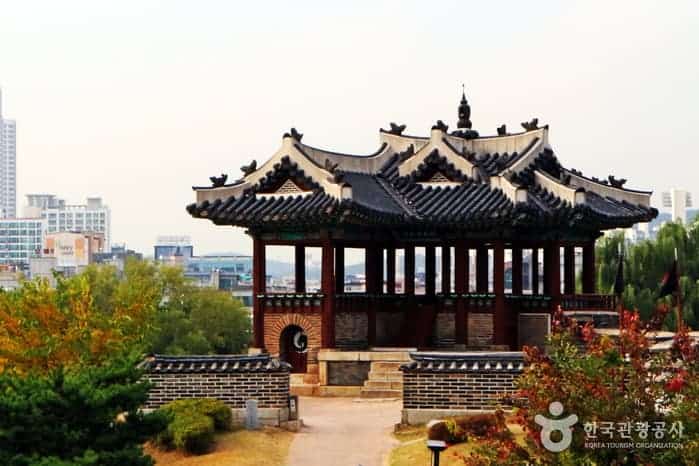
[Source: Korean Tourism Organization]
Among the 40-plus building structures composing the Suwon Hwaseong Fortress, the Banghwasuryujeong Pavillion is known to be the most beautiful. It’s a famous spot for couples to take a romantic stroll enjoying the magnificent natural scenery. The pavilion is located on the east of the Hwahongmun Gate. Though the official name is Dongbukgangnu Pavilion, it’s better known as Banghwasuryujeong, meaning a pavilion where one can “find flowers and stroll among willow trees.” King Jeongjo used this pavilion to rest and bask in the bird-eye-view of Paldasan Mountain.
- Location: 44-6, Suwoncheon-ro 392beon-gil, Paldal-gu, Suwon-si, Gyeonggi-do
- Open Hours: Tue-Sun: 09:00-18:00, Monday Closed
- Contact details: Tel: +82-31-228-4242 / Suwon cultural website: www.swcf.or.kr
- Entrance Fee: Free
- How to get here: The same area as the Fortress. Get off at Suwon station (line 1), take buses 5 or 7 from the station, and get off at the Jagan Park stop.
Flying Suwon (플라잉 수원)
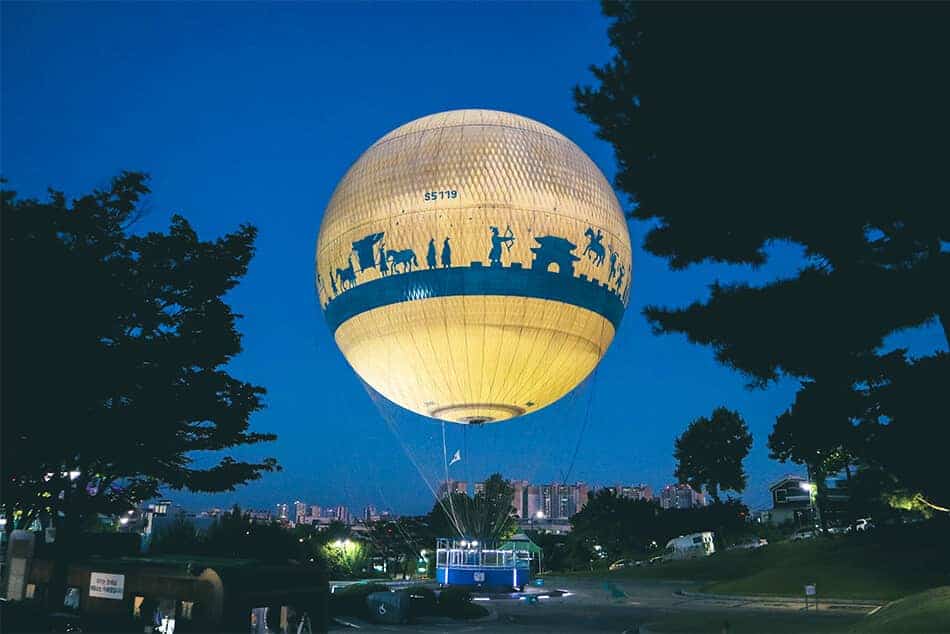
[Source: Korean Tourism Organization]
The Flying Suwon is truly a unique way to see Suwon in its entirety. The tethered hot air balloon flies 150 meters and lasts for about 10 minutes, so there’s plenty of time to enjoy the view from all angles. The perfect time to ride Flying Suwon is at night when the sunset provides warm hues on the horizon. You can also see the twinkling lights from the city for great Instagramable photos.
- Location: 255-4, Ji-dong, Paldal-gu, Suwon-si, Gyeonggi-do
- Open Hours: Weekdays: 13:00-22:00. Weekends and public holidays: 11:30-22:00 (can change based on the weather forecast)
- Contact details: www.flyingsuwon.com
- Entrance Fee: Adult (above 19) 18,000 KRW / Teenager 17,000 KRW / Children 15,000 KRW / Students 12,000
- How to get here: Take Bus No. 2-2 from Maesan Market Bus Stop near Suwon Station (Seoul Subway Line 1, Suin-Bundang Line), Exit 9 towards Changnyongmun/Yeonmudae Bus Stop, and walk for approx. 6 minutes
Check Out The Price of Flying Suwon
Aqua Planet Suwon (아쿠아플라넷 광교)
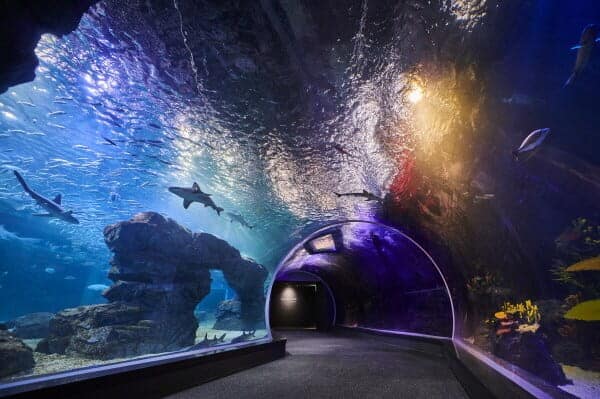
[Source: Korean Tourism Organization]
The new aquarium, Aqua Planet Gwanggyo, is the final attraction in the Suwon MICE Complex. It opened on January 19, 2021. This aquarium follows the other Aqua Planet aquariums in Seoul, Ilsan, Yeosu, and Jeju. Aqua Planet Gwanggyo has a total floor area of 6,500 sq. meters with an aquarium capacity of 2,000 tons. You can see more than 210 types of sea creatures, including sand tiger sharks, otters, and penguins. The main attraction, Ocean in the City, is the largest aquarium tank where visitors can see various sharks and 2-meter-long black manta rays. The aquarium features experience zones including a ‘Jellyfish Lab’ and special shows including an ‘Aqua Music Show’ and an ‘Aqua Art Show’.
- Location: Forena Gwanggyo B1 300, Gwanggyo Lake Park-ro, Yeongtong-gu, Suwon-si, Gyeonggi-do
- Open Hours: Mon-Sun: 10:30-19:30
- Contact details: https://www.aquaplanet.co.kr/gwanggyo/eng/information/facility.do
- Entrance Fee: Adult 26,000 KRW / Children and Elderlies 23,000 KRW
- How to get here: Check their official direction website: https://www.aquaplanet.co.kr/gwanggyo/eng/aquaplanet/location.do

Manseok Park (만석공원)
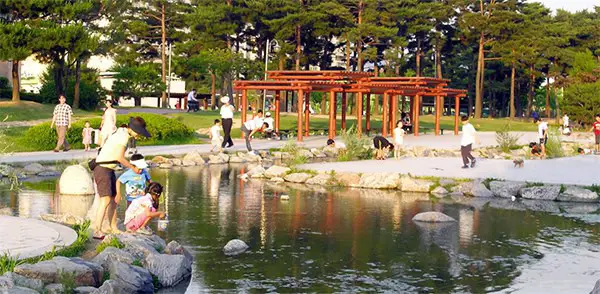
[Source: Touristlink]
The public park, Manseok Park, is located in the Jeongja-dong area of Jangan-gu. A great place to spend a relaxing day, visitors often crowd the centerpiece of the area, a man-made reservoir. There is a 1,200 meter-track around it for walking, running, biking, or rollerblading. There is also a permanent stage for various outdoor events and celebrations, and on the south side, you can visit the Suwon Arts Center. The park also hosts sports venues like the North Suwon Tennis Club and a full soccer field.
- Location: Gyeonggi-do, Suwon-si, Songjuk-dong, 434 KR
- Open Hours: Open 24 hours
- Contact details: +82 31-228-4509
- Entrance Fee: Free
- How to get here: take a bus (777,301,7770,3000) in front of the Suwon subway station.
Gwanggyo Lake Park (광교호수공원)
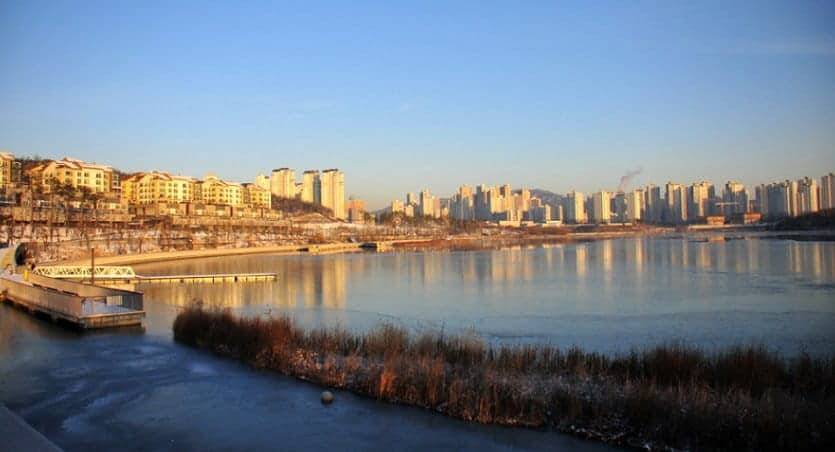
[Source: TripAdvisor]
Want to enjoy a relaxing walk in an open park while breathing in the fresh air at one of the tourist spots in Hwaseong? If you’re tired from a long day of sightseeing, then it’s time to rest in Gwanggyo Lake Park. Gwanggyo Lake Park, located in the middle of the city, offers a beautiful view of the city of Suwon. Surrounded by quite a number of apartments and shops, this park is often a favorite spot for local residents. The best time to visit Gwanggyo Lake Park is at night when the park lights will light up and display a very beautiful light effect from various angles. There are several zones around this park, including Urban Leave, Community Forest, and Mysterious Mulneoumi.
- Location: 57 Gwanggyohosu-ro, Ha-dong, Yeongtong-gu, Suwon-si, Gyeonggi-do,
- Open Hours: Open 24 hours
- Contact details: +82 31-228-4198
- Entrance Fee: Free
- How to get here: Take bus #18 at Gwanggyo Jungang Station
Haewoojae (해우재) / Toilet House
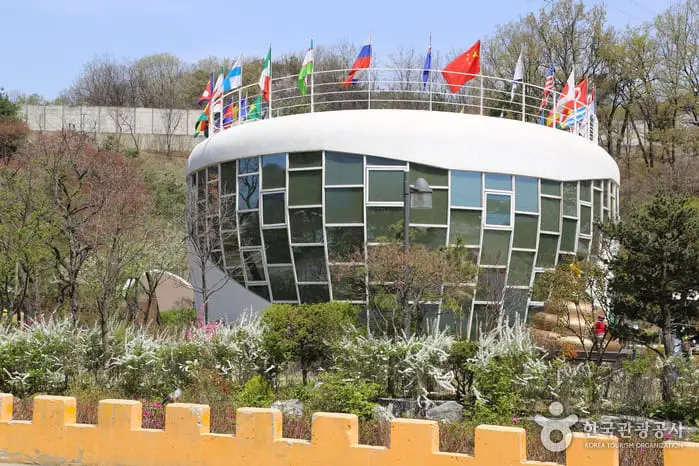
[Source: Korean Tourism Organization]
Aside from the historical sites and nature parks, Suwon also has a very interesting and unique destination. The Toilet House is a museum designed like a toilet and exhibits funny poop and garden sculptures. They also promote more awareness of sanitation issues in Korea and around the world. A children’s museum across the street offers an observation deck for viewing the toilet house. Also, do you know this house is the former residence of the mayor of Suwon, the late Sim Jae-duck? The former mayor is known for his efforts to improve Suwon’s public toilets to prepare for the 2002 FIFA World Cup.
- Location: 463 Jangan-ro, Jangan-gu, Suwon(Imok-dong), Korea 16209
- Open Hours: March-October: 10:00-18:00 / November-February: 10:00-17:00 / Mondays, January 1, Lunar New Year, Chuesok Holiday Closed
- Contact details: 031)271-9777 / https://www.haewoojae.com:40002/eng/load.asp?subPage=110
- Entrance Fee: Free
- How to get here: To get here, you can take bus 65 or 301 from Hwaseong Haenggung. It only takes 25 minutes, when you reach Dongwon Middle School you have to get off. From there, you just need to walk for 10 minutes to the Museum.
Gwanggyo Reservoir (광교저수지)
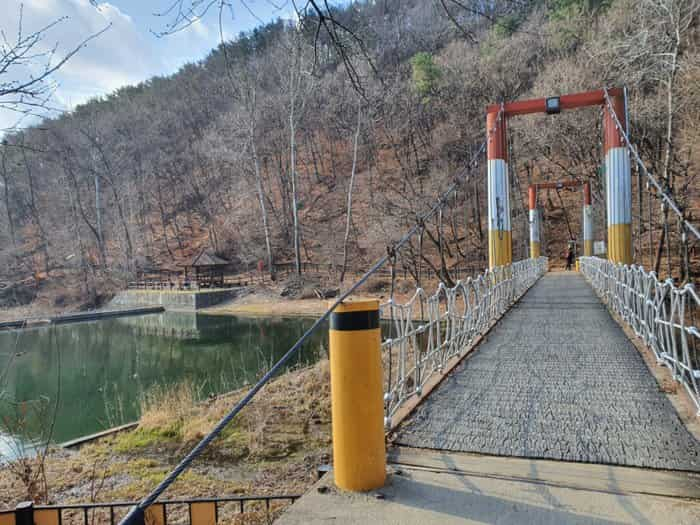
[Source: Safaraway]
The Gwanggyo Reservoir trail is one of Suwon’s most beautiful and scenic trail routes. It circles the city’s reservoir and is surrounded by thick foliage and green lands. The track itself spans two miles or 5,000 steps, perfect for a morning jog or bike to start the day. During summer and spring, you can visit in the early morning hours to enjoy some morning dew and cold breeze.
- Location: 399-2 Hagwanggyo-dong, Jangan-gu, Suwon-si, Gyeonggi-do, South Korea
- Open Hours: Open 24 hours
- Contact details: None available
- Entrance Fee: Free
Chilbosan Mountain (칠보산)
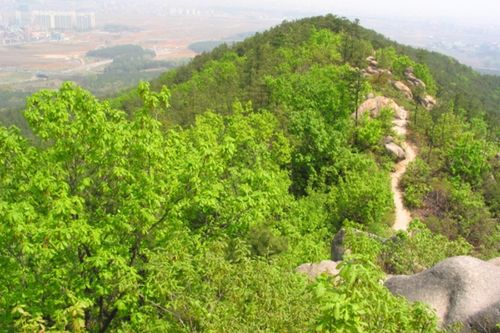
[Source: 수원시청 (suwon.go.kr)]
An hour away from the heart of Suwon, the Chilbosan or Shilpusan Mountain is one of the highest mountains in the region at 906 meters above sea level. It’s a popular hiking trail for local residents to enjoy some peace and quiet while admiring the majestic scening landscapes and surrounding towns.
- Location: 496-5 Dangsu-dong, Gwonseon-gu, Suwon, Gyeonggi-do, South Korea
- Open Hours: Open 24 hours
- Contact details: None available
- Entrance Fee: Free
Hyowon Garden (효원공원월화원)
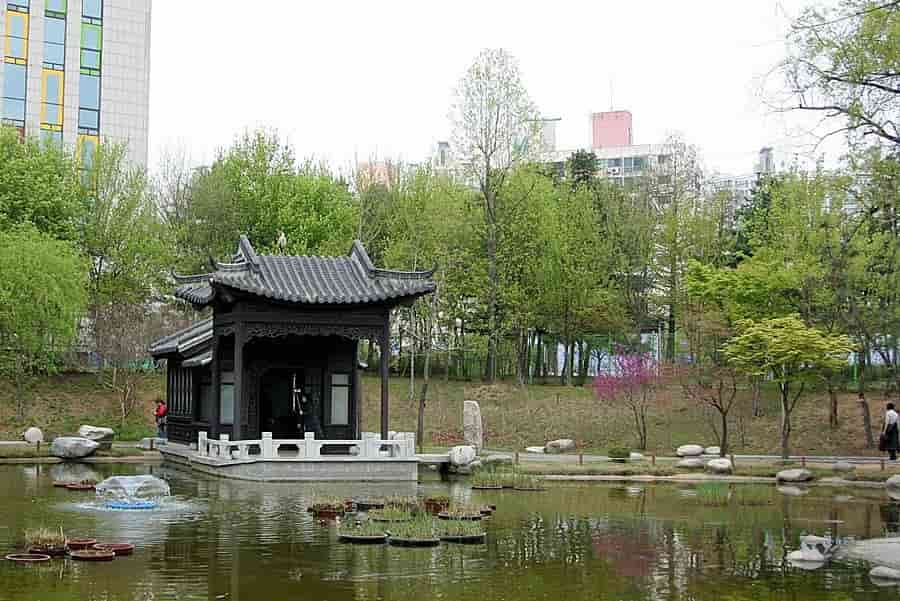
[Source: TripAdvisor]
Are you a fan of the K-drama Scarlet Heart Ryeo? Then you’ll definitely have to visit Hyowon Garden as one of their shooting locations. This public park is built in 1944 in Suwon’s neighborhood Ingye. It’s a walking distance of beautiful cafes, the Gyeonggi Cultural Center and its outdoor theater, and other popular tourist districts. The ‘hyo’ in Hyowon refers to the concept of filial piety and aims to “awaken the feelings of filial piety in growing children.” The most popular attraction is the Wolhwawon Garden located at the park’s north-western point, open to the public in 2006. It’s modeled after the traditional Chinese gardens as a symbol of friendship between Gyeonggi province and the Chinese Guangdong province.
- Location: 397 Dongsuwon-ro, Ingye-dong, Paldal-gu, Suwon-si, Gyeonggi-do, South Korea
- Open Hours: Open 24 hours, Wolhwawon Garden: 09:00-22:00
- Contact details: 031-228-7043
- Entrance Fee: Free
- How to get here: Suwon City Hall Station [수원시청역], Suin-Bundang Line, Exit 10, (14 min. walk)
So those are the top 12 attractions and places to enjoy while you’re in the beautiful city of Suwon. Check our other posts for more tourist recommendations!
You may also like:
- Best Day Trips to Suwon From Seoul
- Things To Do in Yongin Korean Folk Village & How To Get There – Updated 2022
- Is South Korea Open to Tourists Now?
- 14 Best Day Trips From Seoul- Updated
- The Ultimate Guide to Everland Theme Park in Korea
- Autumn Foliage Places to Visit in Korea
IVK’s Top Picks – Day Tours, Tickets, and Travel Activities
Seasonal Picks!😍


